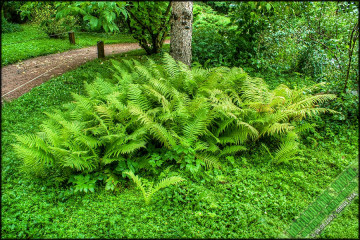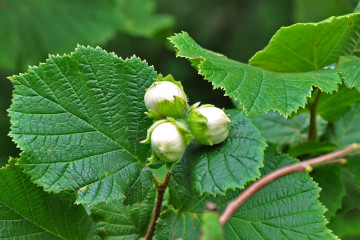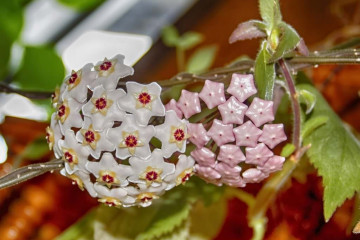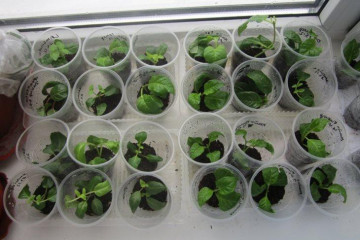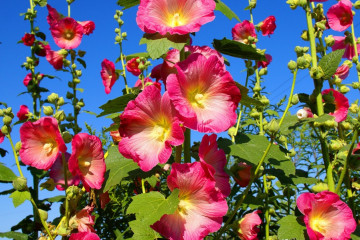How to plant mint in the country - how it multiplies
Content:
- Description of culture
- Popular varieties for growing in the country
- Danger of mint in the garden
- Selection of quality planting material
- Conditions for successful growth of mint
- Optimal timing of planting crops
- Rules for planting mint in the open field, subsequent care
- Reproduction methods
- Harvesting mint
- Problems in growing plants, pests and diseases
Mint is a plant that has been known for a long time. It was used by the ancient Egyptians and Greeks as a medicinal and gingerbread plant.
Description of culture
Mint is a herbaceous perennial plant that has simple stems and bright green leaves. The rhizome of mint is horizontal, with a large number of fibrous roots. The culture reaches a height of 80 to 100 centimeters.
The flowers are usually small, clustered in inflorescences at the tops of the stems. Flowering begins in late June and lasts until early autumn. The fruit consists of four nuts, and is formed in a small part of the plants.
The plant is absolutely unpretentious - does not require fertilizing, frequent watering, perfectly adapts to various conditions of detention.
Mint makes a great addition to chicken, fish, or any other protein-rich meal. It can also be used to season fruit salads. She will give them an unforgettable taste.
Useful properties of mint
Mint is actively used in pharmaceuticals, cosmetology and perfumery. Its beneficial properties are as follows:
- The plant has a calming, antiseptic and antispasmodic effect, eliminates bloating and has a beneficial effect on digestion in general.
- The menthol in the flower is an antiseptic and sedative. It helps with insomnia and nervous excitability.
- For medical purposes, dried leaves are used, from which various phytopreparations are produced.
Popular varieties for growing in the country
Before planting mint, you need to know that its varieties differ in the appearance of shoots and flowers, the content of essential oils and the growing season.
- Peppermint
The peppery plant is the most popular. It is obtained through the hybridization of two species - Water and Garden.
The perennial is compact in size and looks very attractive on the site. Peppermint comes in two varieties - white and black. As for the landing site, it is better to select areas that are well lit during the day and shade in the afternoon.
- Long leaf mint
The variety is in second place in popularity after the pepper. Despite the large amount of essential oil, which is abundant in the leaves, its aroma does not irritate, but rather soothes.
It is important to remember that this variety grows up to two meters in height, so it is important to ensure that it does not obscure its “neighbors” in the area.
- Curly variety
As a rule, it is grown as a spice, as it does not have the “chill” characteristic of other varieties. But its main advantage is its resistance to cold weather.
- Apple variety
This variety is also a hybrid, formed from Fragrant and Longleaf mint.Many owners like to grow this variety at home, because it has a delicate and pleasant aroma, for which it received the second name "confectionery".
- Garden mint
This plant is completely unpretentious, therefore it is suitable for beginners in the field of gardening. Mint grows as a beautiful bush that gets along in any corner of the garden - both in the sun and in the shade.
Danger of mint in the garden
An inexperienced gardener, before wondering how to grow mint, should be aware of the danger this plant poses to the garden.
The fact is that the perennial grows very quickly throughout the site. Its roots, like a cobweb, tighten the space so that it is not so easy to get rid of it.
Therefore, you need to know how to prevent this phenomenon. There are two proven ways:
- Seedlings should be planted when the area intended for mint is fenced with sheets of slate or metal on all sides.
- The fragrant herb can be planted in a bucket and dug into the ground with it so that its rims rise above the ground.
Selection of quality planting material
Good planting material for planting mint can be obtained in a variety of ways. For example, order on the Internet, buy in a specialized store, or prepare yourself if a person is growing a plant. Each of the methods has both pros and cons.
How to choose seeds for planting a plant
Only an experienced gardener knows how to grow a certain type of mint from seeds correctly. Therefore, it is better to pick up seeds in a reputable, well-known store in order to be sure that the variety will match the picture and will give a high similarity.
Rules for choosing mint seedlings
If we are talking about buying ready-made seedlings, then before planting mint in the country, you need to choose it correctly:
- The seedlings should have a firm stem and a strong root, without a single odor.
- There should be no rotten and dry areas.
- The optimum sprout length is no more than 8 cm. If the samples are longer, during transplantation they may not survive adaptation and die.
Conditions for successful growth of mint
Before planting a plant, you need to remember that it grows best in sunny and fairly humid areas. In addition, the plant must be provided with the following growth conditions:
- It is unacceptable to sow a crop near bushes, because with their strong root system they will not allow mint bushes to develop.
- Wetlands are not suitable for grass.
- The plant loves loose and fertile soil. As for the acidity level of the substrate, it usually fluctuates between 6-7 pH.
- In the first half of the day, the site should be well lit, and in the second half - in the shade. How does mint grow in dark areas? According to gardeners, they are completely unsuitable for the culture, the plant does not take root well and dies over time.
- It is also worth noting that if the culture stays in the same area for several years, it will become weak, not fragrant, and will dry out over time.
Optimal timing of planting crops
Those wondering when is the best time to plant mint seeds should know that it is best taken in early spring. In this case, with the arrival of winter, the bushes will not disappear. If you plant mint in July or later, the roots will not have time to take root, which will lead to their death in severe frosts.
As for the fall, even experienced gardeners do not always risk planting mint on the site at this time. By winter, many cuttings will not be able to take root, especially in the northern regions of the country.
Rules for planting mint in the open field, subsequent care
Mint, planting and caring for which outdoors requires effort, will then retain all its medicinal properties when all recommendations are followed.
Before planting fragrant mint in open ground, you need to familiarize yourself with the planting rules:
- It is recommended to germinate the material first. To do this, you need to plant the seeds in the usual way and cover them with a damp cloth on top, send them to a warm place.
- When the first sprouts begin to sprout, observing the rules of transplantation, they need to be planted in containers to a depth of approximately 6-7 mm. The room should be warm, in it, under a closed film, they will stay for about two weeks.
- After 14 days, move the containers to a cool place so that the sprouts get stronger and get used to temperature extremes.
- How to properly plant mint in open ground after the sprouts have grown stronger? Just like other cultures. Only in advance you need to add organic or mineral fertilizing to the soil. After that, dig up the soil, make shallow dimples and plant mint. At the end of the planting, water the bushes with warm water.
This plant is completely unpretentious. In order to get a fragrant crop, you need to water it as necessary and get rid of weeds, pulling them out and loosening the soil.
Also, for better growth, mint should be fed. In addition, it is important to adhere to the following guidelines to learn how to properly care for mint:
- With the arrival of spring, prune the plant so that it grows better and the bushes are more luxuriant.
- In the fall, you need to mulch the mint and sprinkle it with plenty of peat so that it does not freeze in severe frosts.
- The bushes should be renewed every 4 years, as their roots are destroyed and the plant degenerates completely.
Reproduction methods
For a long time it has been known that mint can be propagated by seed and vegetatively.
Seed breeding method
As described above, it is not very easy to grow mint from seeds, you need to buy several bags in advance due to poor germination. In addition, hybrid varieties cannot be diluted with seeds at all.
Who wants to try it, you need to sow the plant in early spring, draw shallow grooves with a glanders, plant seeds, sprinkle with compost on top and leave under a film for two weeks.
The optimum temperature for seedlings is from 20 to 25 degrees. During this time, it is necessary to control the humidity and make ventilation so that the seeds do not rot and do not trample. When two leaves grow, cut open and place in separate pots.
After another couple of weeks, the seedlings can be planted in open ground.
Vegetative way
As you can see, mint propagates by seed method is not so easy. As for the vegetative method, it includes three breeding options - by dividing the bush, by root cuttings or stem cuttings.
When the stem is the stem, then you need to cut off the process about 10 cm and put it in the water. The room should be warm and well lit. When the roots grow, you can transplant the sprout into the ground.
Cuttings may not be placed in water, but planted in wet sand. When they take root, plant in the ground.
To breed mint with root cuttings, they must be separated from the mother plant and buried in a cool and bright place. With moderate watering, the sprout will take root.
Those owners who want to plant mint by dividing the bush must dig up the plant, clear it of the earth and divide it into equal parts. Each of the parts must have buds and shoots with roots. After a couple of weeks, the mint will take root. How exactly to plant a plant is up to the hostesses and owners to decide.
Harvesting mint
When 3 weeks have passed after the first shoots appear, the plant will look lush and fragrant.It will grow up to 30 cm in height and it will be possible to shoot the first crop, remembering that after pruning, the crop will grow more intensively.
To dry a plant, it must be spread out on a flat surface to dry. Next, separate the stems from the leaves and, if desired, grind.
Problems in growing plants, pests and diseases
In order for the culture to remain blooming and fragrant, at the sight of pests or affected sprouts, they must be cut out immediately, because they cannot in any case be added to food.
The main reason for the appearance of mint diseases is too frequent watering and poor air circulation. In this case, you need to carefully dig up the soil and not water it for a while.
The main pests of a young culture are:
- The mint flea is a common pest that damages the roots and leaves of the plant. Therefore, after collecting mint, you need to treat the area with a special concentrate.
- The leaf beetle is another dangerous pest that appears on waterlogged damp soils. Why is it especially difficult to fight him? Because special means cannot always cope with it. Therefore, it is necessary to create conditions in which the leaf beetle will be uncomfortable - less often to water the site and better ventilate.
- Powdery mildew is a familiar white bloom that resembles a cobweb. It usually infects the leaves of the crop. To prevent it from appearing, you should not plant the mint too close to each other. In addition, you need to regularly weed, pulling out the weeds. Treat the affected leaves with colloidal sulfur, and then burn them, because it is in them that a serious focus of the disease is located.
- Very often mint lends itself to such a disease as rust. This phenomenon is first seen on the roots, and then passes to the inner side of the leaf. At the sight of this serious disease, you need to immediately remove all affected stems with leaves, no matter how sorry for the plant.
If you know about these intricacies, it will be possible to take preventive measures for the plant in order to avoid the appearance of infections. This is very important, as any poison makes the mint completely unusable. It cannot be added to food and tea, and it is also prohibited to dry.
In conclusion, it should be added that mint is a unique plant. As you can see, planting and caring in the open field requires little effort, but if you manage to get a good harvest, the whole family will be delighted with the aromatic spicy tea on a warm summer evening.





